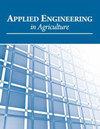Effect of Aspergillus Flavus Fungi Infection and Aflatoxin Contamination on Single Corn Kernel Mechanical Strength
IF 0.8
4区 农林科学
Q4 AGRICULTURAL ENGINEERING
引用次数: 1
Abstract
HighlightsKernels were artificially inoculated with toxigenic and non-toxigenic strains of Aspergillus flavus in the lab.Corn kernel mechanical strength was assessed as single kernel compression rupture force (CRF).Fungus-infected kernels had lower mechanical strength than the controls.Kernels with high aflatoxin contamination had lower mechanical strength than others.ABSTRACT. One persistent food safety issue associated with corn is aflatoxin contamination. Aflatoxins are secondary metabolites produced mainly by the fungi Aspergillus flavus (A. flavus) and A. parasiticus. Under environmental conditions suitable for fungal growth and aflatoxin production, these fungi are capable of infecting corn kernels in the field and in storage. When corn kernels are infected, the fungi use nutrients from the kernels to grow and propagate. In general, moldy and contaminated kernels are discolored and lighter in weight. These features could aid in the identification and removal of infected kernels. The objective of this research was to investigate the relationship between the mechanical strength of corn kernels and fungal infection, as well as aflatoxin contamination as a consequence of fungal infection. Corn kernels were infected with aflatoxin producing (AF13) and non-toxin-producing (AF36) A. flavus strains in lab inoculations. A total of 900 kernels were assigned to three groups, non-inoculated control, AF13-inoculated, and AF36-inoculated. One hundred kernels from each group were incubated for 3, 5, and 8 days. After incubation each kernel was cleaned and dried, then subjected to a destructive mechanical test. The compression rupture force (CRF) of each kernel was measured using a Mark-10 material test gauge to assess its kernel strength. The results show that kernel strength was significantly different between the control and treatment groups, with the control kernels being the strongest and the AF36-inoculated kernels the weakest. The results also indicated that kernels with aflatoxin contamination of 300 ppb and above were significantly weaker than control kernels and those less contaminated in the AF13-inoculated group. It is expected that the results of this research could benefit the corn industry by mitigating the aflatoxin contamination problem in post-harvest management. Keywords: Aflatoxin, Aspergillus flavus, Compression rupture force, Corn, Fungus-infected, Inoculation, Mechanical strength.黄曲霉侵染和黄曲霉毒素污染对玉米单粒机械强度的影响
在实验室中人工接种了产毒和不产毒的黄曲霉菌株。采用单粒压缩破裂力(CRF)评价玉米籽粒机械强度。真菌感染的果仁机械强度低于对照。黄曲霉毒素污染程度高的籽粒机械强度较低。与玉米有关的一个长期存在的食品安全问题是黄曲霉毒素污染。黄曲霉毒素是主要由黄曲霉和寄生真菌产生的次生代谢物。在适宜真菌生长和黄曲霉毒素产生的环境条件下,这些真菌能够侵染田间和贮藏中的玉米籽粒。当玉米粒被感染时,真菌利用玉米粒中的营养物质生长和繁殖。一般来说,发霉和受污染的果仁变色,重量较轻。这些特征有助于识别和清除受感染的核。本研究的目的是研究玉米籽粒的机械强度与真菌感染之间的关系,以及真菌感染引起的黄曲霉毒素污染。用产黄曲霉毒素(AF13)和不产黄曲霉毒素(AF36)菌株对玉米进行室内接种。将900粒玉米分为3组,分别为未接种对照、接种af13和接种af36。各组各取100粒,孵育3、5、8 d。孵育后,每个仁被清洗和干燥,然后进行破坏性机械试验。采用Mark-10材料试验规测定各仁的压缩破裂力(CRF),评价其仁强度。结果表明,对照和处理组间籽粒强度差异显著,对照最强,af36接种组最弱;结果还表明,af13接种组黄曲霉毒素污染300ppb及以上的子粒,黄曲霉毒素污染显著弱于对照子粒和污染较少的子粒。预计本研究结果将通过减轻收获后管理中的黄曲霉毒素污染问题,使玉米工业受益。关键词:黄曲霉毒素,黄曲霉,压缩破裂力,玉米,真菌感染,接种,机械强度
本文章由计算机程序翻译,如有差异,请以英文原文为准。
求助全文
约1分钟内获得全文
求助全文
来源期刊

Applied Engineering in Agriculture
农林科学-农业工程
CiteScore
1.80
自引率
11.10%
发文量
69
审稿时长
6 months
期刊介绍:
This peer-reviewed journal publishes applications of engineering and technology research that address agricultural, food, and biological systems problems. Submissions must include results of practical experiences, tests, or trials presented in a manner and style that will allow easy adaptation by others; results of reviews or studies of installations or applications with substantially new or significant information not readily available in other refereed publications; or a description of successful methods of techniques of education, outreach, or technology transfer.
 求助内容:
求助内容: 应助结果提醒方式:
应助结果提醒方式:


